Short-Term Rental Agreement Templates
Popularized on homestay listing websites, a short-term rental agreement allows for great flexibility. This is why it is preferred by many vacationists or travelers. It is important, however, to know which aspects should be covered by a lease agreement. With the information below, you can confidently rent out your investment property without much difficulty.
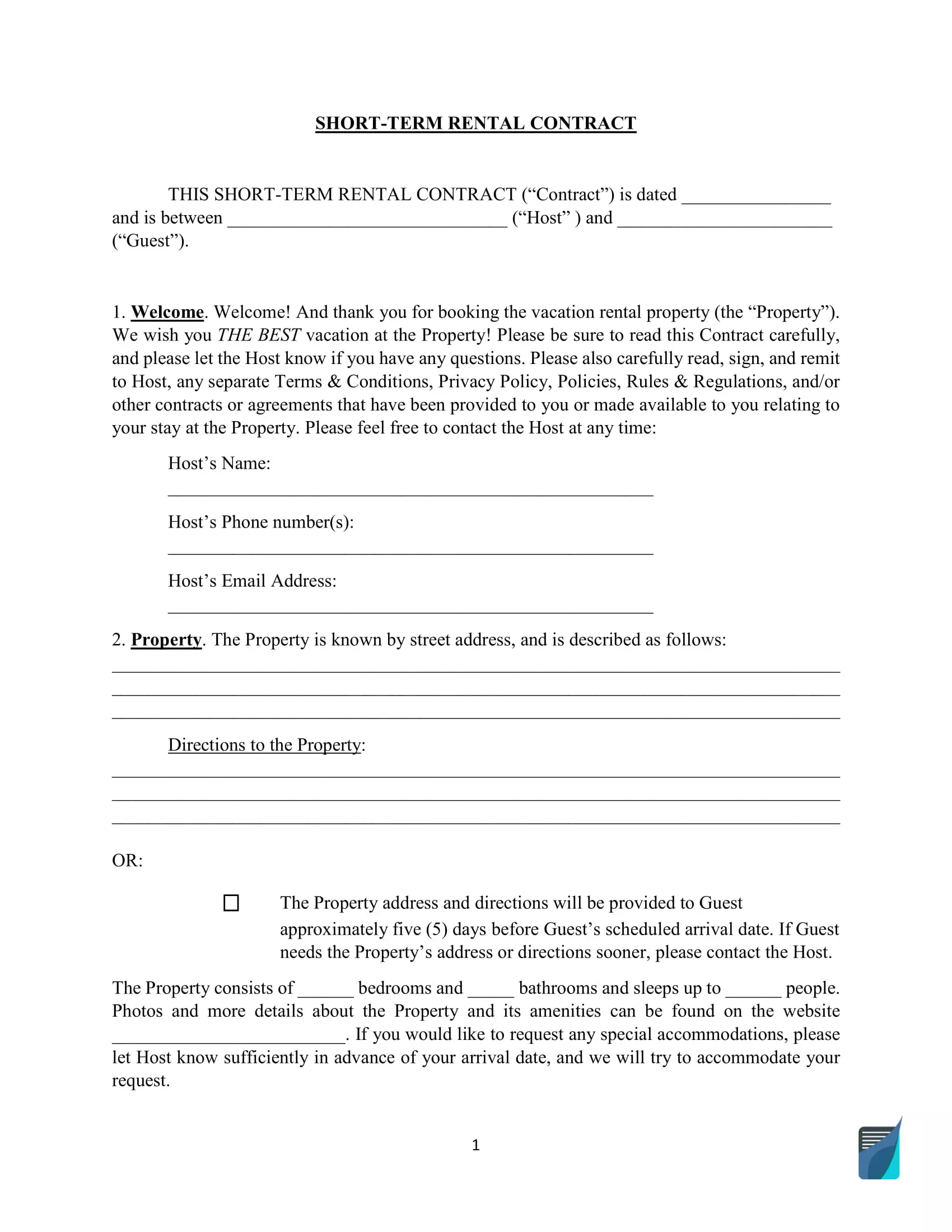
Build Your Document
Answer a few simple questions to make your document in minutes
Save and Print
Save progress and finish on any device, download and print anytime
Sign and Use
Your valid, lawyer-approved document is ready
What is a Short-Term Rental Agreement?
A short-term rental agreement typically lasts between one and 30 days. During this short period of time, tenants are considered “guests” and use a fully-furnished unit. This is why a short-term rental agreement is also called a “vacation rental”.
This type of accommodation is the popular set-up for homestay sites. While these websites conveniently create an automatic lease agreement between the tenant and landlord, they also take a big commission fee. Because of this, most landlords opt to rent out directly.
For this type of lease, you’ll be encountering the following terms:
- Property — This is the room, unit, or house under the vacation rental lease agreement.
- Landlord — This is the person who owns the premises and oversees your accommodation.
- Tenant — The primary guest that will be staying on the premises. He or she is also one of the signatories of the vacation rental agreement.
- House Rules — Like a typical lease, the landlord may write a fixed set of house rules. This is necessary so that the investment property is well-maintained.
- Amenities — These are the additional facilities or features to make the tenant’s stay more convenient (e.g. Wi-Fi, hot and cold shower, towels, etc.)
Unlike normal leases, short-term leases can be less detailed. However, this does not mean that crucial provisions will be left out. In fact, a short-term vacation agreement must be covered by unique provisions that marry together a hotel agreement and a typical lease. All these will be covered in this article.
When and How to Use a Vacation Rental Agreement
When should you use a short-term rental agreement?
Though there are other alternatives such as a month-to-month lease agreement or a short online contract, a short-term rental is used for the special reasons below:
- To accommodate a big group of vacationers
Big groups typically need a bigger space. However, hotel rooms have limited capacity and do not have a common area. You can offer this type of rental to these types of guests.
- To cater to local travelers
A good number of local travelers prefer direct short-term rental. Because of this, landlords who offer homestay accommodations can benefit from this market.
- To do away with listing fees
People use online listing platforms to feel more secure. The downside to this is fees and additional expenses that are paid to the platform. Frugal vacationers will choose direct accommodations instead.
- To open your property for events
Before the pandemic, big flashy event halls were used for gatherings. However, the recent change shifted the venue of events. If you’re a real estate property owner who has a spacious backyard or conference room, you may advertise it as an event venue.
How to use a short-term rental agreement
When using short-term lease agreements, make sure that both the landlord and the tenant write their complete details. They will have to indicate their full names, addresses, and several other private information. This is necessary to ensure the safety and security of both parties. Rest assured that they are also obligated to keep the information confidential.
Once finished, the short-term lease will be governed by the applicable law. Since rental laws vary from state to state, the landlord must check if their agreements are acceptable. The best way to do this is to review the guidelines published on your state’s or city’s website. As an alternative to drafting your own contract, you can also use FormsPal’s free short-term lease agreement template. This abides by national regulations and most state laws.
What Can Happen Without the short-term lease agreement
Oftentimes, landlords are tempted not to “do the paperwork.” However, when dealing with strangers who come and go, it is highly encouraged that you have a written lease agreement. Without a vacation rental contract, you might be victims of scams or theft.
Aside from security purposes, a rental contract will protect both you and the tenant. In case anything happens, the contract can stipulate guidelines for property damages, disputes, accidents, and insurance claims. If you do not have lease agreements in writing, these types of problems can be quite chaotic to handle.
How to Rent Out Property for a Vacation
A vacation rental agreement has similar processes that are observed in typical leases. Still, there is much confusion about its process. Follow the steps below when deciding to do this business:
Step 1 – Check common guidelines for hotel or homestay operators
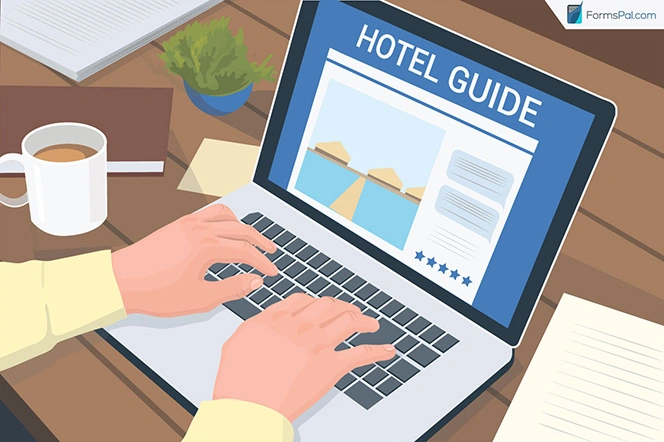
Short-term leases are like watered-down versions of hotel or homestay accommodations—you don’t need to serve your tenant 24/7, but you do need to be reachable and help them around. When starting this business, it will be helpful to familiarize yourself with good hotels and how they “host” bookings.
Step 2 – Select applicable house rules

After this, you may write a list of house rules. Try not to be too strict as you still want your tenants to enjoy their vacation or have a comfortable stay.
Step 3 – Furnish your property and Prepare Amenities

Making your property similar to hotels is not required. However, do make it convenient for your guests. Furnish your property with necessary things and prepare amenities for your tenants’ convenience (e.g. towels, pillows, etc.)
Step 4 – Take Pictures

Once you have everything ready, take high-quality pictures. Feature all your rooms and areas, including the amenities you’re offering.
Step 5 – List your property
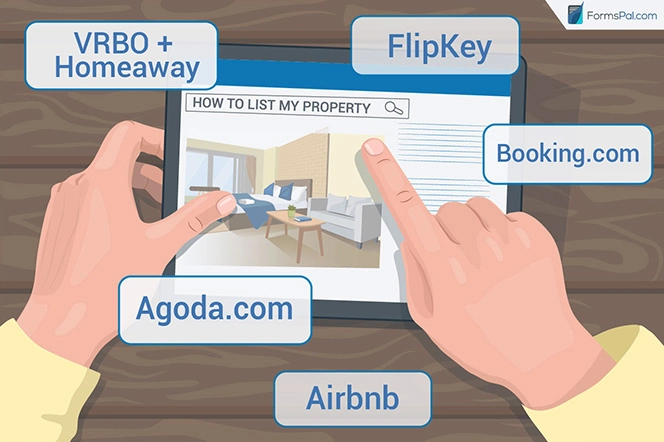
There are two ways to list your property:
#1– Directly
Making bookings directly means you’re setting up your own marketing campaign. In addition, you’ll have to secure permits and other business licenses. This is great if you don’t want to pay additional fees. You can make a Facebook page or even a website and advertise these through social media.
#2– Via an Online Platform
Using online platforms is also a great way to start. Not only do they ease the burden of registrations and cover you with insurance, but it also teaches you how to host tenants. You also do not need to do much effort in marketing, since the platform advertises your real estate property. However, these sites take as much as 25% for every successful booking. In addition, you must also prepare real estate documents to become accredited. Some of these sites are the following:
- Airbnb
- VRBO + Homeaway
- FlipKey (by TripAdvisor)
- Craigslist
- Booking.com
- Agoda.com
Step 6 – Respond to bookings and do background checks

Quickly respond to short-term lease inquiries. However, do not confirm any booking until you check their social media account and verify their identity.
Step 7– Finalize the agreement

To finalize the agreement, you’ll need the vacation rental template plus their security deposit. In a short-term rental, a security deposit is also called a down payment. This is crucial just in case anything happens or the booking is canceled at the last minute.
Step 8– Orient the tenant

In this setup, you’re not only one of the property owners, but you’re also the “host.” You’ll have to orient your tenant about your house rules and about the community. Teach them how to get around and provide a tourism flyer, if you can. All of this must be done before their check-in date.
Step 9– Welcome the tenant

The room or the rental property must be clean once the tenant arrives. You may assign someone to facilitate check-in, give the guests a tour, reiterate the rules, provide information, and hand over the keys.
Step 10– Follow the check-out procedure

When the tenant is ready to go, have them sign a check-out form. Make sure all your items (towels, sheets, toiletries, utensils, etc.) are accounted for. Then, return their deposit. If they had a good time, ask them to leave a review on the website.
Short-Term Rental Agreement Form Details
| Document Name | Short-Term Rental Agreement Form |
| Other Names | Vacation Rental Agreement, Short-Term Rental Contract |
| Avg. Time to Fill Out | 12 minutes |
| # of Fillable Fields | 64 |
| Available Formats | Adobe PDF |
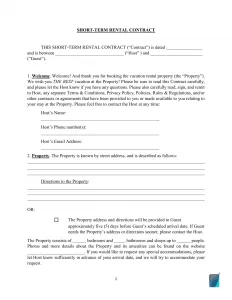
Steps to Filling Out a Vacation Lease Agreement
Step 1— Download the template.
Select your preferred file type below:
• Short-term Vacation Rental Agreement Template – Open Office Format (.odt)
• Short-term Vacation Rental Agreement Template – Microsoft Office Format (.docx)
Step 2— Put your details in the first paragraph.

Start the short-term lease agreement with the following details:
•Blank 1: Indicate the date of the agreement.
•Blank 2: Write the full name of the landlord or property owner.
•Blank 3: Write the full name of the tenant or guest.
Step 3— Fill out the welcoming paragraph.
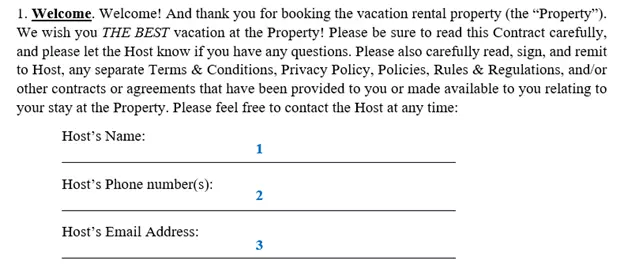
•Blank 1: Indicate the “host” or designated contact person during the stay.
•Blank 2: Write both the mobile number and phone number.
•Blank 3: Lastly, indicate the host’s e-mail address.
Step 4— Add details about the property.
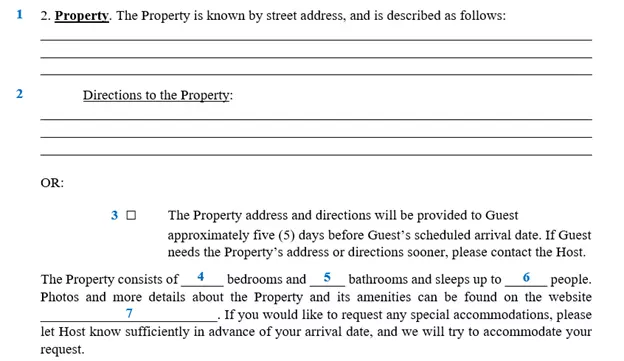
•Blank 1: Write the complete street address of the real estate property including the floor, house number, street name, county/city, state, and zip code). You may also add an additional description or landmark.
•Blank 2: In detail, write how the guest can get to the property.
•Blank 3: Alternatively, you may choose to leave out the directions. If so, tick the box (3).
•Blank 4: Then, write the number of bedrooms.
•Blank 5: Add the number of bathrooms.
•Blank 6: Write the maximum number of guests allowed to stay at the property.
•Blank 7: If your property is listed on a platform or has its own website, write the link here.
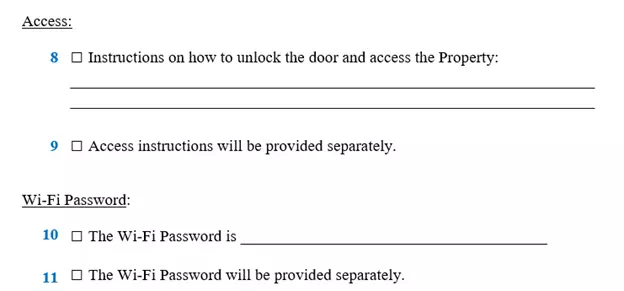
•Blank 8: You may add further instructions for the guest (e.g. where to get the keys or how to unlock complicated locks).
•Blank 9: Again, you may choose to leave out the directions. If so, tick the box (9).
•Blank 10: Add the Wifi password.
•Blank 11: You can also leave out this detail and provide it at a later time. Tick the box (11) if this applies.
Step 5— Write when the vacation lease agreement begins.

•Blank 1: Write the duration of the rental.
•Blank 2: Indicate the date and time when the guest can check-in or begin their tenancy.
•Blank 3: Include the date and time when the guest must check-out or leave the property.
Step 6— Read the conditions.

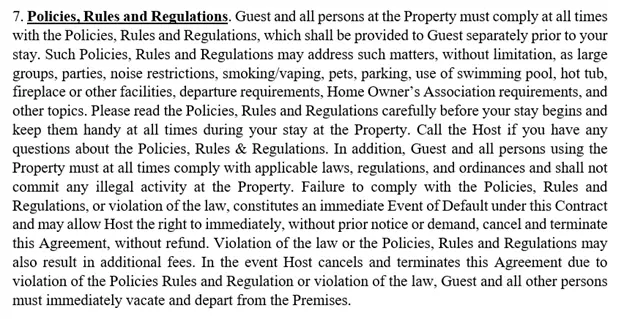


Sections 4, 7, 9, 10, and 11 are standard clauses for the protection of both the landlord and the tenant. It is best to go other the polices and conditions
Step 7— Write the names of Guests.

In Section 5, write the following:
•Blank 1: Names of all the guests or family members.
•Blank 2: Total number of guests.
Step 8— Provide details about the rent and fees.
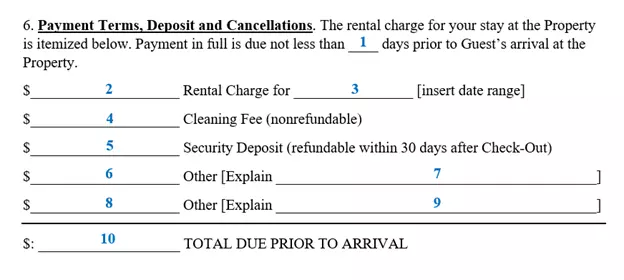
For Section 6, write the following payment details:
•Blank 1: The number of days that represents when the rental payment is due
•Blank 2: Amount of rent
•Blank 3: Check-in and check-out dates
•Blank 4: Additional amount for cleaning fee or area maintenance
•Blank 5: Amount of security deposit
•Blank 6: Any other additional fees
•Blank 7: Explain the additional charges on Blank 6
•Blank 8: Any other additional fees
•Blank 9: Explain the additional charges on Blank 8
•Blank 10: Total amount due

For cancellations, the following will be applicable:
•Blank 11: Tick this box if the guest can still request for a refund.
•Blank 12: If so, write the refundable amount.
•Blank 13: Add the dates when the refund can still be claimed (usually at least 7 days before the check-in date).
•Blank 14: Choose this box if the full amount cannot be returned.
•Blank 15: Tick this box if, aside from rent, other fees will also be withheld.
•Blank 16: Elaborate on the non-refundable fees.
Step 9—Orient the guest about the check-out procedure
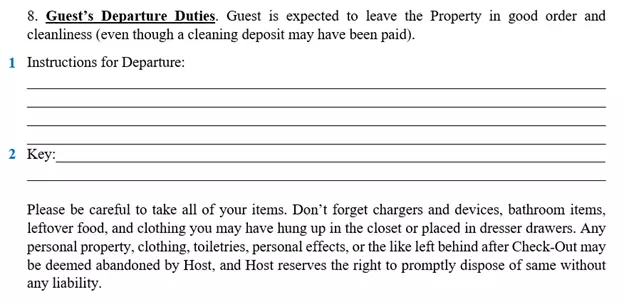
•Blank 1: Give instructions on how the guest should vacate the rental property.
•Blank 2: Write the complete information regarding how the key must be returned.
Step 10—Read through the additional provisions.
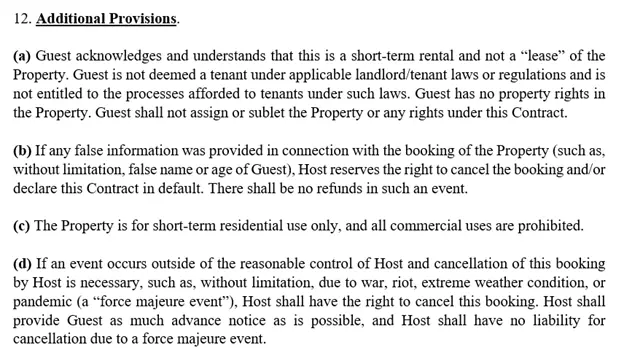
Read paragraphs A to D of Section 12.
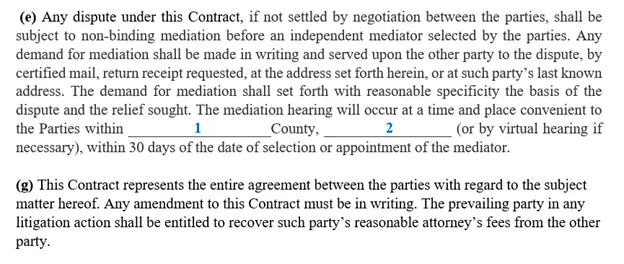
In case of disputes, write the following:
•Blank 1: Write the county that will be in charge of the proceedings.
•Blank 2: Write the state that has jurisdiction over the contract. It will also be helpful to review its laws before
Step 11—Sign the contract.

Finally, both parties must sign on the last page of the agreement as well as the rest of the pages.
•Blank 1: Company name of the landlord or host (if the property is owned by a company)
•Blank 2: Signature of the landlord’s representative
•Blank 3: Representative or landlord’s full name.
•Blank 4: Position of the representative.
•Blank 5: Company name of the tenant or host (if sponsored by a company)
•Blank 6: Signature of the landlord’s representative
•Blank 7: Representative or landlord’s full name.
•Blank 8: Position of the representative.
A short-term rental agreement seems simple, but it contains several clauses to protect both the landlord and the tenant. It is also unique because landlords need to be more hands-on, especially when they try to host a booking. FormsPal’s short-term rental agreement template can remove the complicated part of this business and help both parties have a pleasant experience.
